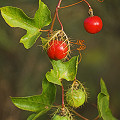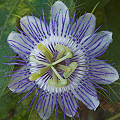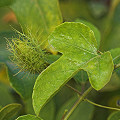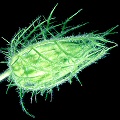Q: What is Passiflora like?
A: The genus Passiflora (passion flowers, passion fruit)
contains about 350 vine species that live in warm or tropical habitats.
Only one species, Passiflora foetida, is thought to be a potentially carnivorous plant.
When the plant flowers, it makes glandular bracts. Digestive enzymes have been
found inside the plant's tissues, but not on the bract surfaces.
I have grown this plant once. It germinated in both peat:sand and regular potting
soil mixes. It enjoyed being kept moist, and tolerated both full and partial sun.
It produced long, tendril-bearing, climbing branches and soon became an annoyance
in the greenhouse. The flowers were typical passion flower in layout, but only
lasted for a few hours. Fruit were produced from my plants, perhaps by pollinators
in the greenhouse. (Only a tiny fraction of all the flowers yielded fruit--I do
not know if this was due to a lack of pollinators or
because of other issues.)
Alas, the plants I grew did not have glandular bracts. The bracts were highly
branched ("dissected"), but not glandular. I have been told this is
because not all the varieties in the species have such glands.
Perhaps because of the lack of glands, I saw no carnivorous or prey-capturing
activity.
I have also seen plants in the wild, in the Sonoran desert (Arizona, USA) and near an estuary (Yucatan, Mexico). These
plants were more glandular, but I saw no signs of captured prey.
Page citations: Radhamanim, et al., 1995; Rice, B.A. 2006a;
Schlauer, J. 1998; personal observations.



